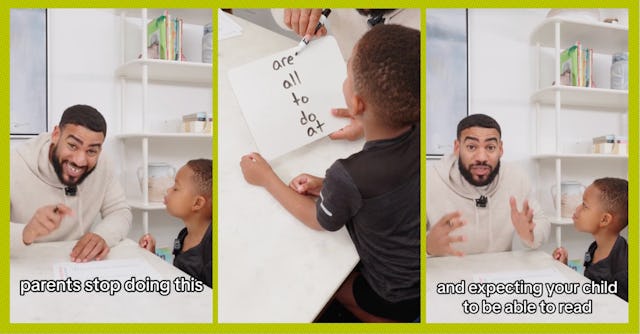This Former Teacher’s Easy Method For Teaching Toddlers To Read Is Going Viral
And there are no *sight* words in sight!

If you've got a child heading into kindergarten this fall, you'll probably become familiar with the long lists of sight words they'll be bringing home pretty soon. While memorizing sight words is just one way for young children to achieve grade-level reading capacity, Spencer Russell, a former teacher and founder of Toddlers CAN Read, is going viral for teaching toddlers to read with his phonetic approach that goes beyond memorization.
"Whenever we're teaching a child to read, we want to focus on building skills that they can translate to new and unfamiliar words: not just the words they've seen before or the words they can guess based on context," says Russell.
He goes on to explain that "[...] young children who appear to be reading in kindergarten because they've memorized a lot of words [have] never actually learned the two most important skills to be able to read almost any word in the English language: 1) the letter sounds (phonics) and 2) how to blend those sounds together into words."
At the toddler stage, these skills may not be crucial, but if gone untaught, not learning to read is a problem that can affect every aspect of their lives — from relationships to career opportunities and even their health. And the sobering fact is that many adults never learn to read. According to the National Literacy Institute, roughly 40 percent of students in the U.S. cannot read at a basic level, and over 20 percent of adults remain illiterate.
Keeping watch for the signs that your child is ready to begin learning to read and coupling them with the building blocks of reading can set them up for lifelong literacy success and a love of reading.
When should parents successfully teach their children to read?
There's no set timeline for when children should begin learning to read. And because reading is a skill that is learned versus one that comes naturally, Spencer says that the when is entirely up to parents and is more about an unwavering belief in their potential to learn and succeed in anything they set their minds to. But to help parents better determine their child's readiness, he shared these four signs:
- Oral Language: Learning to read requires the ability to physically pronounce sounds. Learning letter sounds is one of the first and most important parts of learning to read.
- Memory: Children need to be able to remember the sounds they've learned. If they can remember basic objects (think: colors, shapes, and names), they likely already possess the memory capacity needed to begin learning to read.
- Focus: Children need to be focused on the sounds they're learning. Because learning to read doesn't require more than a few minutes per day, many kids can focus long enough to begin learning to read.
- Desire: Both the child and parent need to be interested in the process. Forcing the process can lead to anxiety that can end the learning process before it's begun.
How can parents successfully teach their children to read?
Every child learns differently, so parents will need to adjust their approach based on what works best for their child. This could be everything from time, location, and style. Though Spencer says to build the foundation for reading success, parents can start with the basics and just three easy tips:
- Teach them the sounds each letter makes: Parents can turn this into a fun experience by incorporating this step into activities or games they enjoy. Focus on just two to three letter sounds at a time until they have mastered them.
- Teach them how to combine sounds into words: Practice hearing and blending sounds or seeing and blending sounds. For example, help them combine the sounds each letter can make to help them understand how words are constructed (C-U-P, etc.).
- Build a strong reading routine: Read to your children often, but also have your child read to you!
In addition, consider:
- Time: Pick a time when you and your child are at your best.
- Space: Choose a calm space, whether in the home or outdoors.
- Transitions: Be very intentional about how you transition into and out of the reading time. Keeping the same activities before the reading time and giving a five-minute warning beforehand can help your child ease into the lesson. Ending each lesson with a celebration or fun activity can also help keep your child looking forward to it daily.
And remember to be patient with yourself and your child. Having a shorter lesson, skipping a lesson, or asking for help from another adult are healthy ways to modify the process while still achieving long-term progress.
For additional early learning resources, check out this list:
This article was originally published on